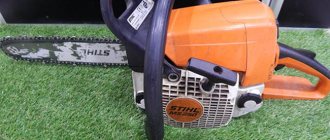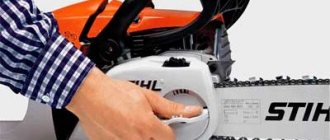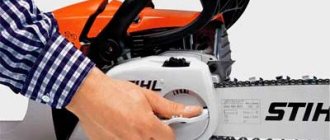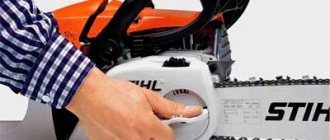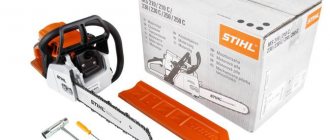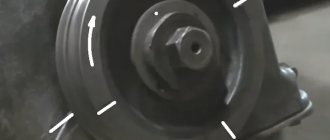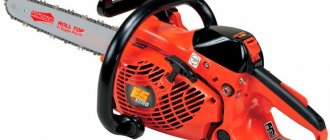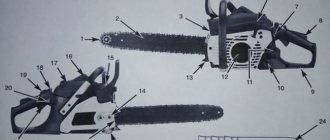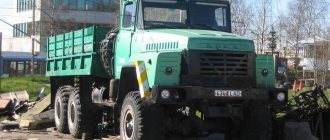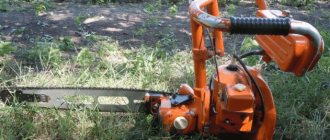Question: What are the weak points in the Shtil ms 250 chainsaw?
Answer: in my opinion: It was possible not to spin the engine like that. There is enough power. Uncompensated carburetor.
Whether this should be considered a disadvantage, I don’t know - many manufacturers still do not compensate, and nothing, but on all produced Shtilevsky saws, except for 230 and 250, they are compensated, but these were left without. Although the design of the air filter is such that compensation for its contamination is not really necessary.
It is not convenient to clean the cylinder fins - the top cover cannot be removed and you have to remove the starter and get dirt out from under the cover. Not a frequent procedure, but sometimes necessary.
When constantly working on construction, before opening the oil tank lid, it would be good to sweep it with a brush first - little sawdust gradually accumulates in the tank and eventually blocks the oil line.
Oil supply is too small. It’s not that there’s not enough, but more wouldn’t hurt. Again, these are modern standards. There's no escape. And so - there are no special complaints - the design is old, all the shortcomings have been eliminated.
Question: The problem is this: the STIHL MS 250 saw has been in use for six years. Oil is not supplied to lubricate the chain (it does not depend on the air temperature); to be precise, it does not go towards the tire, but at the same moment during operation it intensively flows into the hole under the muffler.
I cleaned and wiped everything, but everything remained the same. Tell me, what else can be done?
Answer: Sometimes it happens. There, under the muffler, there should initially be a plastic plug. For some reason it sometimes gets squeezed out.
You can do it, here's what you need: Socket wrench "8" - remove the muffler. Long M6 tap - about 100 mm long, or standard with an extension. M6 screw, which is not a pity and the corresponding nut. Hacksaw for metal. Vise.
Here is the technology: 1 — Remove the muffler. 2 — Remove oil leaks. 3 — We lower a small piece of cloth with a slight tension into the hole so that it can be removed later.
Don't score too tightly! 4 - use an M6 tap to cut 5-6 threads in the hole, clean the chips and remove the cloth from the hole with a hook. 5 - from the M6 screw we cut a piece with a length of threads 5 - 6 (or 5-6 millimeters), on this piece we cut a slot for a screwdriver. - the plug is ready. (The above-mentioned nut is used to tighten the screw through it and not damage the thread).
6 - screw the plug into the hole. You need to be careful here - you can’t screw it in deeply, otherwise it will block the outlet hole. You can insert a wire 2 millimeters in diameter into it from the tire mounting side and screw in the plug until it touches the wire. 7 — install the muffler and check the oil supply.
Question: I bought a Stihl 250 chainsaw. A week later I discovered a leak of black oil at the crankcase mounting point, running from under the screw, it is located on the right, closer to the handle. There are suspicions that the crankcase may not be sealed. What to do?
Answer: don’t worry - the leakage does not appear outwardly. No drips or similar manifestations. Only by indirect signs - first a slight increase in power and an increase in maximum speed.
Then, as the leakage increases, problems with idling begin, then problems with starting.
Question: Saw Shtil ms 250 starts and stalls. How to fix?
Answer: You first need to remove the fuel filter from the hose in the tank and try to work without it for a little while. It won't do anything - check the impulse hose - it's hard to see, but you can see it.
Using a small flashlight, look into the gap between the top of the fuel tank and the bottom of the carburetor box - the hose should not dangle loosely - it should be put on a nipple cast integrally with the carburetor box body. Sometimes it happens - when the engine slams, it breaks off.
If the hose is in place, then it’s more difficult. Rock the right end of the crankshaft - if there is even a slight play, you need to do a diagnosis.
The screws securing the pan may be loose, or the oil seal (usually the right one) may be damaged. I can also advise you to move the carburetor from a working saw and try to see if that’s the problem.
Question: I bought a Stihl MS 250 chainsaw. I came to the dacha, started it up, tried to cut it - everything is fine. Well, I move the universal lever to the stop position, but it doesn’t stall! In general, I took off the cover and closed the contact. Can you enlighten me on the device for stopping the engine?
I saw only one contact on the spring, and the second one was stuck into the universal lever itself and there was nothing else! It looks like there should be some kind of record there, but what kind?
Answer: At the end of the wire there is a regular female contact. It is inserted into the corresponding socket on the lever and the contact spring should touch it when the lever is in the “off” position.
There are no intermediate parts. There should be a spring on top. It has not so much a contact function as one that locks the shaft in different positions.
Question: I use a Stihl 250 chainsaw. I haven’t started the saw yet, I have no experience, so I have a few questions. 1. I was surprised by the operation of the brake, or rather, the sound with which it turns on, such a sharp, unpleasant click, the whole saw resonates, is this normal?
2. The drive sprocket is all black and red, it should all be silver-metallic. What does this mean? 3. There was no tire in the box, it was given separately. Wasn't this a reason to be wary?
Answer: The brake engages with a fairly loud click and the impact is felt. There is a powerful spring there, there is something to click. It's not clear from the star, you'll have to look it up. Tire and chain - yes, separately. The main thing is that both are Shtilevskoe.
Question: after the saw warms up, does the idle speed disappear or stall? If you don’t let off the gas, then you can work; when you let off the gas, it stalls. It starts up normally all the time, but when it’s hot, you have to press the gas to start it, otherwise it won’t start at idle, tell me what’s the problem?
I wanted to clarify about the idle speed (the chain spins) on the Shtil 250 chainsaw. I know that there are two screws in the saw that can regulate the idle speed. One LA, which can be turned by the user, the second L - it seems to be advisable to turn it at the service station, so as not to harm the saw.
According to the instructions, the user is allowed to turn these two screws, and only if this does not help should he contact service. Should I mess with the carburetor settings to optimize idle speed? If yes, what is the algorithm of actions?
Answer: There are three adjustment screws. “H” shouldn’t be turned at all, and it’s better to do the main idle adjustment “LA” - it’s just a persistent throttle screw.
The “L” screw is connected to the idle speed, but is more “responsible” for engine acceleration and transition mode, so it is better not to touch it, if possible.
In general, the 250s were characterized by a “buggy” idle. Depending on the year of manufacture and the installed carburetor model, of course, but sometimes it was not possible to achieve a normal idle at all.
Either it's too high and it spins the chain, or it stalls. And sometimes it “floated” - you adjust it, it seems to be normal, and suddenly - once again, it accelerates. Or vice versa - it falls. In general, it is not always possible. So turn down the idle “LA”, whatever happens is what happens.
Source: benzpila.ru
Chainsaw Shtil 250 faults and repairs
With all the variety of modern building materials, wood species remains very important. That’s why woodcutters, landscaping workers, and summer residents are interested in woodworking tools, in particular chainsaws.
The Shtil chainsaw is easy to use, inexpensive, reliable, and has a long service life.
Different people prefer different brands. Someone is interested in the Partner chainsaw, someone is interested in the Shtil brand device, someone is interested in something else. But they break down periodically, and their breakdowns are both similar and different. Next, we’ll look at how to repair a Shtil chainsaw yourself.
This brand is well known both among experts and among individuals involved in arranging their own living space. The great popularity of the Stihl chainsaw determines the frequent practical use of this tool and forces one to find methods for an effective snowball fight with its usual breakdowns.
Required special tools for repair
Before starting repair work on the Shtil chainsaw, you need to prepare the necessary set of tools. A chainsaw is not a technically complex tool; to assemble and disassemble it, simple working tools that every man has on the farm are sufficient. But since the chainsaw comes from Germany, and the Germans are very pedantic people, there is a special Stihl tool for more comfortable repairs.
The Shtil multi-tool is made of high-quality hardened steel in a housing made of impact-resistant polymer. The tool is very practical and compact in size. It contains screwdrivers: a 3.50 mm slot for cleaning carburetor grooves and adjusting it, a Torx TX27 screwdriver.
Depending on the combination key model (0000 890 3401 or 129 890 3401), the tool has a set of spark plug keys from 16, , 19, respectively. The original multifunctional Shtil comes in a durable nylon case with a belt clip.
Stihl ms 250 repair (Part 1)
As mentioned earlier, the inspection of a faulty saw tool should begin with establishing the presence of gasoline in the fuel tank, as well as determining the technical condition of the breather.
Repair of a Shtil chainsaw in case of a malfunction in the accounting software (software) for fuel supply.
When checking the fuel level, you should immediately open the gas tank cap. This must be done even for which the design is intended, if the owner of the tool can be sure that there is gasoline in the tank.
Often the saw is unable to start due to fuel not entering the combustion chamber. The prerequisite for this in most cases is the usual clogging of the breather - a special bypass valve that serves to equalize the pressure in the container with the gradual consumption of gasoline. Here, repairing a chainsaw comes down to carefully cleaning the breather with a regular sewing needle.
A prerequisite for failure of the entire tool will be an inoperative starting mechanism or problems in the ignition system. If it turns out that the starting device works as usual, then you need to make sure that the spark plug is working properly. In order to do this, the spark plug is unscrewed from the socket and closely inspected, looking for the presence of foreign deposits on its electrodes.
Chainsaw starter device.
It should be noted that the presence of traces of a certain characteristic at the site of spark formation speaks very eloquently about the sources of “disease” of the entire starting accounting system. Such a source, for example, could be a carburetor. Thus, the complete absence of any signs of fuel on the spark plug (its complete dryness) most likely indicates a failure of fuel to pass into the combustion chamber due to a workable version of a clogged carburetor.
Reference!
Adjusting the carburetor of the Stihl chainsaw may be necessary when the quality of the fuel changes, the altitude at which the Stihl chainsaw is operated (air rarefaction), as well as when the atmospheric pressure, temperature and air humidity change. Adjusting the chainsaw carburetor allows you to achieve excellent chainsaw performance when external operating conditions deteriorate. Also, adjusting the chainsaw carburetor helps prevent oil starvation and engine damage due to insufficient lubrication entering the cylinder with a lean fuel mixture.
Tip: To check the tightness of the engine, it is very good to use a special device, i.e. special pump with pressure gauge. First, you need to remove the carburetor on the chainsaw, and install a sealed plate plug with a flange on the inlet port of the cylinder with a flange for connecting the hose from the pump. The spark plug can also be placed on a sealant for sealing. You also need to remove the muffler and install a sealed plate with a rubber gasket on the cylinder exhaust window. Then you need to put the piston at top dead center and connect the hose from the pump to the flange. Next, you need to pump air into the engine to 0.9 atm. and look at the pressure gauge needle - if it stands still, then the engine piston is sealed. Then we release the air, switch the device (pump) and begin to pump air out of the cylinder, creating a vacuum in the engine with a pressure gauge reading of -0.5 atm. We look at the pressure gauge needle - if it stands still, it means there is no air leakage through the oil seals or other seals in the engine (which impairs the operation of the chainsaw and does not make it possible to correctly adjust the chainsaw carburetor). This way we check the engine for air leaks and compression.
How to disassemble, repair and assemble a Shtil chainsaw
To repair the device, it must first be disassembled. It is necessary to remove the side cover, saw chain and bar. Then clean the tool, blow it out with a compressor and clean all the components with a brush. Then remove the handle. To do this, remove the plugs from the shock absorbers using a screwdriver. After this, remove the shock absorbers and handle.
Then remove the starter. Remove the housing cover and unscrew the starter screws. Remove the part. Then remove the flywheel, unscrew the nut that holds it, and unscrew the flywheel nut. You need to turn left. Remove the flywheel. Then dismantle the clutch, oil pump drive and carburetor.
After this, the motor is removed and disassembled. It is held on by 4 screws on the bottom of the saw. You need to unscrew them and remove the motor. Then the engine itself is disassembled. Unscrew the crankcase screws and remove it. Then the crankshaft, seals, bearings and piston rings are dismantled. Upon completion of disassembly, repairs and troubleshooting are carried out.
After repair, the instrument will need to be put back together. To do this, install the piston on the connecting rod. The arrow on it should point along the chain, and to the left of the piston there will be the side of the crankshaft in which the flywheel needs to be mounted. Place the piston in the cylinder. Install the bearings, seals and retaining ring into the cylinder. After this, degrease the place where the crankcase is fixed and install it in its place. When reassembling, follow the reverse dismantling sequence.
How to remove the clutch
Before unscrewing the clutch, you need to remove the drive sprocket. Remove the corkscrew washer and remove the sprocket and needle bearing. Unscrew the clutch. Remove the reflector plate and pump.
How to remove and replace a sprocket
Replacing the sprocket on a chainsaw is necessary in cases where:
- jams chain movement;
- The drive sprocket has worn out.
To replace, you need to remove the chainsaw sprocket. The sprocket teeth must not deviate from the required dimensions, otherwise the operation of the saw will be accompanied by vibration, which will lead to damage to the crankshaft and bearings. The service life of the sprocket is 2 times longer than the working life of the chain. Use 2-3 chains until their cutting surface wears out. After this, change the sprocket. It is located behind the clutch. Remove the clutch assembly cover.
Remove the bar, chain and clutch. But first you need to fix the crankshaft. Then the puller is placed in the coupling hole and turned clockwise. Remove the coupling. Behind it is an asterisk. Now it is being dismantled. If it is faulty, it is replaced.
Oil pump repair and replacement
Let's look at how to change the oil pump. If the element leaks, the gasket between its two parts should be updated. If this part of the oil pump is not damaged, then it must be wiped and put back in place. Now check the hose. There should be no cracks on it. If the hose is damaged, it is replaced. Then they clean the outlet channels with a compressor.
Replacing the piston
Let's look at how to diagnose and replace the piston group. It is necessary to check the condition of the cylinder and the degree of wear of the piston. After dismantling the engine, unscrew the pan and remove the crankshaft and piston from the cylinder. Unscrew the piston pin stoppers. If the piston is faulty, it must be replaced. The retaining rings are fixed with the cut down. Before installing the piston group into the cylinder, lubricate the piston with oil. Before installing the crankcase, degrease its surface and apply sealant.
How to set the ignition
You need to turn on the ignition on the chainsaw. Ignition adjustment is carried out as follows:
- unscrew the spark plug and evaluate its appearance;
- specify the distance between the magnets and the coil (up to 0.2 mm);
- check the spark.
Cleaning the chainsaw muffler
If the functional elements from the hose to the spark plugs of the chainsaw have been checked, but the equipment still stalls when you press the gas, you can assume that the muffler is faulty. This is due to the fact that the tool has been used for too long. The consequences were the accumulation of dirt and sediment and debris. Large quantities of sediment are formed when low-quality fuel is poured into the tool.
To check whether there is carbon deposits in the muffler or not, remove it:
- Unscrew the nuts.
- Remove the muffler.
- Remove the plate and reflective part.
Make sure that the studs remain in place during dismantling. If carbon deposits are found, the muffler is cleaned using one of the options below:
- Suitable for dismountable tools. When the muffler is removed, they go over the inside with a wire brush. It will remove a thick layer of carbon deposits, but will not reach the deep layer. Fine-grained sandpaper will help remove the inner layer. Finally, apply a chemical solution to the muffler. Next, dry the part thoroughly and install it in its place in the chainsaw.
- The non-demountable design requires skill. Mechanical cleaning is carried out in the most accessible, open places. Pour shot into the muffler and shake the part. It wouldn't hurt to add a chemical solution. You need to leave the liquid in the muffler for 3-4 hours. During this time, it will properly corrode the dirt and remove deposits during subsequent blowing.
Repair of the Stihl MS 250 chainsaw. Maintenance of the Stihl 250 chainsaw
Qualified repair of Stihl (Calm) chainsaws in . We are the official service center of this brand. This guarantees strict adherence to technology and the constant availability of original spare parts in our own warehouse. By contacting us, you can restore your equipment in the shortest possible time and without overpayments.
The STIHL MS 250 chainsaw is a lightweight, productive chainsaw for household needs.
Advantages of this chainsaw:
- 2.3 kW motor. This model is equipped with a QuikStop chain brake, an effective braking system responsible for safety.
- convenient lateral location of the saw chain tensioning mechanism
- the presence of preheating of the carburetor, allowing you to start the engine at low temperatures.
Technical data of the Stihl MS 250 chainsaw
| Power, hp | 3,1 |
| Weight, kg | 4,6 |
| Specific gravity, kg/kW | 2 |
| Chain pitch | .325 ".3/8" P |
| Sound power level, dB(A) | 114 |
| Oil tank volume, cm³ | 200 |
| Vibration level left/right, m/s² | 5,7-6,9/6,8-8,9 |
| Sound pressure level, dB(A) | 99 -101 |
STIHL recommends that maintenance and repair work only be carried out by an authorized STIHL dealer.
Setting up the carburetor model
The professional chain saw Stihl MS 250 requires carburetor adjustment in the following cases:
- when the engine is unstable at idle speed;
- in the case when the internal combustion engine starts and immediately stalls;
- with a sharp increase in the volume of fuel consumed;
- with a noticeable increase in vibration of a running engine.
Adjustment of the fuel unit is performed in the following sequence:
- First, screws H and L on a chainsaw with a cold internal combustion engine must be tightened clockwise until it stops. After this, both screws must be turned 1 turn in the opposite direction;
- Next, you need to start and warm up the chainsaw engine. The operator must then press and hold the throttle trigger. At the same time, by turning screw H, you need to achieve the maximum engine speed indicated in the instructions for the saw. They should be 10,000 rpm;
- Then you need to adjust the operation of the saw chain. To do this, the standard LA screw must be turned so that the chain begins to rotate slowly. After this, the LA bolt will need to be turned 1/4 turn counterclockwise.
MAINTENANCE INSTRUCTIONS FOR THE STIHL MS 250 CHAINSAW
Weekly
- checking saw chain tension and sharpening condition
- deburring the guide bar
- checking the chain sprocket
- cleaning the fan housing
Monthly
- checking and cleaning the suction head
- checking and cleaning the filter in the fuel tank
- replacing the filter element
- Cleaning the fuel tank and lubricating oil tank Cleaning the cylinder fins
carries out scheduled and emergency repairs, as well as maintenance of chainsaws in accordance with the recommendations of equipment manufacturers.
How to check the ignition coil of a chainsaw?
There are several effective ways to test a factory ignition coil. The first of them is visual. To do this, the operator must carefully remove the magneto from the saw structure, having first disconnected all contacts connected to it. After this you need to inspect the part.
Most often its malfunctions are:
- damage to standard insulation, initially caused by gradual or sudden overheating, increased vibration, as well as voltage surges in the created electrical network. All this leads to a short circuit in the factory coil windings;
- violation of the integrity of standard high-voltage wires - this results in overload and breakage of electrical wires.
In any of these cases, you will need to replace your gasoline chainsaw's electronic ignition immediately.
The second way to test a coil is to test it with a multimeter.
To do this you need:
- Connect the device to the positive and parallel negative factory contacts, having previously configured it in the mode of constant measurement of the generated resistance;
- After ringing the built-in coil, you need to look at the device. In household chainsaws from different manufacturers, resistance values may differ from each other. Typically, averages are around 0.4–2 ohms. If the multimeter you are using displays zero resistance, then an accidental short circuit has occurred in its standard winding. In a few cases, the device may show infinity - then the operator will need to find an open circuit.
Each method allows you to obtain information about the serviceability and stability of the factory ignition system of a gasoline saw. In some models of garden power tools, manufacturers provide the ability to replace only the faulty coil. In other cases, owners of chainsaws are required to replace the entire ignition system.
OUR STIHL CHAINSAW REPAIR SPECIALISTS:
- They will carry out diagnostics and determine the type of breakdown of the chainsaw: diagnostics of the tool when contacting our service center is carried out within one day;
- will prepare and explain the repair plan: we will write down your contact information to agree on the timing and cost of the repair;
- troubleshoot problems quickly and efficiently.
Urgent repair of the chainsaw is possible.
Also in our service center you can sharpen your old chain or buy a new one.
Sharpening cost: 120 rubles!
You can also find out the repair price for the Shtil 250 chainsaw by phone. To do this, try to describe the existing malfunction in detail to our specialist. Please note that accurate and complete information about the nature of the breakdown can only be obtained from an official service center.
We are waiting for you in our workshop in St. Petersburg!
Source: ruki24.ru
Instructions Shtil 260
The manual for the Shtil MS 260 chainsaw is a document developed by company specialists who know how to properly use and maintain the chainsaw. It describes almost everything about the saw, from how to make the first start and ending with how to cut down trees correctly. Reading the instructions will be useful not only for novice users, but also for those who have been using this chainsaw for many years.
Running in Shtil MS 260
One of the important issues discussed in the manual is running in the chainsaw. Reading the section describing the correct starting and running-in will help you avoid mistakes during its implementation, because such errors can lead to dire consequences, including major engine repairs.
Safety
Another important section that is recommended to be read and taken into account is the “Security” section. This section provides information on how to operate the Stihl MS 260 with minimal risk of injury. After reading this section, you can find out what personal protective equipment you need to use when operating the saw.
Trimmers and chainsaws
1) Malfunctions of the STIHL MS 180 chainsaw: The gas button gets stuck, and over time the gas button stops moving completely. Cause: A coating of translucent resin on the carburetor throttle shaft, which leads to jamming of the throttle mechanism. Tar is formed when gasoline dissolves poor-quality choke coating. Troubleshooting a chainsaw: Clean the carburetor throttle axis with acetone, and tin the air damper itself with tin.
2) Chainsaw malfunction: The chainsaw “does not pull.” Cause: Carburetor clogged. Chainsaw repair: Disassembling the chainsaw carburetor and cleaning it. When cleaning the carburetor, special attention should be paid to cleaning the additional filter (the mesh in the carburetor of the chainsaw) - remove the largest cover on the carburetor, remove the membrane under it and clean the mesh in the recess from dirt (be careful not to lose this mesh). Of course, clean it with a thin copper wire, rinse and blow through all the channels in the chainsaw carburetor.
3) Malfunction of the Shtil 180 chainsaw: The idle speed of the chainsaw has increased (the idle speed adjustment is not effective and stable). Cause of malfunction: Air leakage through the crankshaft seals or elsewhere. Troubleshooting a chainsaw: Replace the crankshaft seals and check other possible suction points.
4) Malfunction of the chainsaw: After disassembling the carburetor, the chainsaw is difficult to start, white smoke comes out of the muffler. Reason: When disassembling the carburetor, a spring was lost under the needle lever; as a result, the needle does not shut off the fuel supply and the spark plug is “flooded” with gasoline. Troubleshooting a chainsaw: Find and place a spring under the needle lever in the chainsaw carburetor.
5) Chainsaw malfunctions: The chainsaw does not start well and does not work well. Reason : The spark plug is “flooded” with gasoline due to the needle sticking in the carburetor or the rocker arm being raised high. Do-it-yourself chainsaw repair: Rinse and blow out the carburetor, set the rocker arm correctly.
Operating principle
The purpose of the carburetor is to prepare the working mixture for supplying it to the engine cylinders. This mixture is gasoline and air in the proportions required for engine operation. If this ratio is violated, the engine will not operate smoothly. When the mixture has a lot of gasoline, then in layman's terminology it is called saturated, and if, on the contrary, there is little, then it is lean. But in any case, a failure in the proportions of the working mixture will have a bad effect on performance.
Different models of chainsaws may have different carburetor designs, but according to the principle of operation they are all identical. Air moves through a special channel at a speed that can be adjusted by closing or opening the damper. Gasoline, in turn, enters the carburetor through jets and mixes with air there, creating a special mixture that enters the engine.
The pressure in the float compartment of the carburetor, where gasoline is present before mixing, is close to atmospheric. When the damper is opened, there is more air, as well as gasoline, due to which the engine speed increases. This creates a vacuum in the air channel and gasoline is drawn into the air flow. This is the principle of operation of a carburetor.
In order for the chainsaw to operate smoothly and efficiently, and also without high fuel consumption, its carburetor must be adjusted accordingly. Before such work, you must first check the air and gasoline filters. If dirt is found on them, they should be replaced.
Setting up a chainsaw for most models is usually done using three screws - high and low speed and idle speed.
The following signs should indicate correct configuration:
- The chain should not move at idle.
- The motor runs smoothly.
- There should also be no interruptions in work at start-up.
Repairing a chainsaw carburetor with your own hands must be done very carefully, because any mistake made can lead to serious consequences, even to the point of complete engine failure. If you do not have enough experience, it is better to seek the help of a specialist.
Malfunctions of the Shtil 180 chainsaw
It's either sucking air somewhere, or something is clogged.
The main ways to troubleshoot the STIHL MS 180 chainsaw are to disassemble, wash and bleed the carburetor, change the fuel filter in the tank, check the fuel hoses for cracking (they can suck in air). There is only one adjusting screw on the carburetor - idle speed (sometimes I turned it and the chainsaw started working again). The connection between the carburetor and the cylinder is reliable in terms of air suction - there is a plastic ring there (no gaskets are needed).
Inspection or preparatory work with a chainsaw
Inspection, preventative and preparatory work with a chainsaw are clearly demonstrated in this video. Any instrument requires attention. In order for it to serve you efficiently and reliably in the future, these works should be carried out in a timely manner.
Need to do a little research. Acceleration of the device is initiated. It is necessary to evaluate the proper operation of the engine during maximum speed. When the engine is functioning correctly, it means that when you press the accelerator, the speed quickly increases to 15,000 rpm.
If this does not happen or the increase in speed is too slow, you need to use the screw marked with the letter L. Repairing the carburetor of lawn mowers and chainsaws, repairing the trimmer calm with your own. It turns counterclockwise. Moderate movements must be observed, since the turn cannot be more than 1/8 of a full circle.
Currently reading: Husqvarna 137 chainsaw: how to disassemble and reassemble, how to adjust the carburetor
Chainsaw malfunction Shtil 250 (chainsaw carburetor malfunction):
Immediately after starting, the chainsaw operates at high speeds, and if you press the gas, instead of starting to accelerate, it “chokes” and even stalls. Or it starts poorly, does not pick up speed and stalls (this chainsaw malfunction also applies to other expensive chainsaws with an accelerator pump in the carburetor).
Cause of chainsaw malfunction: Wear of the rubber cuff on the piston of the accelerator pump in the carburetor (fuel accelerator). This leads to air leakage from the accelerator pump and the main jet supplies a lean fuel-air mixture (there is little gasoline in the mixture) into the diffuser, and the chainsaw first operates at high speeds, and then “chokes” and stalls. This happens after 2-3 years of operation and usually happens in the hot summer months.
Why does a chainsaw stall when you press the gas?
If the chainsaw stalls when you press the gas, you may suspect insufficient fuel supply to the system. This can happen not only at the time it is put into operation, but also under heavy load that has not previously been observed. This happens when the saw encounters an obstacle in the form of wood that needs to be cut. In this case, it operates at a stronger power than when simply pressing the gas.
Different states of chainsaw spark plugs
When the unit stalls when you increase engine speed, you may suspect that the fuel filter is dirty. You can easily clean it yourself. If a breakdown of the carburetor jet or another element is detected, it is best to take the chainsaw to a mechanic for repair. When the device starts up but quickly turns off, you may suspect that fuel fluid is being poured onto the spark plug. Sometimes the air filter just gets dirty.
If a malfunction is detected with the chainsaw, it should be checked after it has cooled down. It is undesirable to touch hot parts; this can lead to negative consequences.
Troubleshooting a chainsaw carburetor
Remove the carburetor from the chainsaw. Remove the fuel pump cover with the membrane by unscrewing one screw in the center of the cover. Next, turn the carburetor towards you with the throttle valve, on the side where there are two holes, in one you can see a pin, and under it there is an accelerator pump. Remove the retaining ring from the outside of the pin and disconnect the wire spring of the air damper. Unscrew the screw in the center of the throttle valve, remember how the throttle valve is positioned (so that you can put it that way later) and remove the throttle valve. Plug the hole with the pin with your finger (the accelerator is spring-loaded and if you remove the throttle axis and do not close the hole, the accelerator will pop out), then turn the throttle axis and remove it. Shake the accelerator (piston) with the spring out of the hole. There is a rubber cuff (ring) on the piston - its wear is what causes the chainsaw to malfunction. It is necessary to replace the piston with a rubber cuff and a spring (they are sold as a repair kit). Or you can remove the worn piston with the spring, and plug the hole by pushing a rubber plug in there (the chainsaw will not have an accelerator pump, that is, it will accelerate not in 3 seconds, but in 4 seconds, but it will work well since there will be no suction air from the carburetor).
Assembly after troubleshooting the chainsaw (after eliminating the malfunction of the chainsaw carburetor) is carried out in the reverse order of disassembly. When assembling the throttle valve, before tightening the screw, the throttle valve itself must be positioned correctly so that it does not jam, and the threads of the screw securing the throttle valve to the axle should be degreased and coated with a special thread sealant (sold in small tubes, red, liquid) or flattened with pliers, because if this bolt gets unscrewed during operation, it goes straight into the cylinder) and repair or replacement of the piston cannot be avoided). So we looked at how to fix this chainsaw problem.
Source: chainsaws-portal.ru
Lubrication system malfunctions and how to fix them
The main malfunctions of the oil supply system on a chainsaw can be divided into two main types: these are general malfunctions inherent in all chainsaws and individual ones, which may vary depending on the type of pump and worm gear installed on a particular model. Let's begin to understand the faults in order.
Operating a chainsaw without lubricating the chainsaw chain is prohibited. This has a detrimental effect on the bar, drive sprocket and chain, and can result in significant repair costs.
Signs of a malfunction of the lubrication system, checking its performance
- The chainsaw chain is dry and has a pale tint without shine.
- The chain stretches relatively quickly.
- The tire is very hot and may even partially melt the paint.
- The oil from the tank is practically not reduced.
- Reduced cutting efficiency on a sharp chain
All these signs indicate that the lubrication process is not proceeding properly. In order to check the oil supply to the lubrication system, you need to remove the side tire of the chainsaw and start it. Next, you need to slightly increase the speed while observing the end of the oil line. If oil comes in, most likely the amount is not enough for normal lubrication and you need to clean or replace the filter and, if possible, adjust the flow. If it does not, the problem is more serious and requires further diagnosis.
There is a way to check the oil supply without removing the tires. To do this, you need to point the end of the bar towards, for example, a freshly cut piece of wood from the side of the cut and increase the speed as much as possible, while trying to keep the end of the bar at a distance of no more than 10 cm from the block. If oil spots begin to appear on its surface, it means the oil is being supplied.
Troubleshooting
Once it has been determined that oil is not being supplied, further diagnosis is only possible if the oil system is completely removed. Of course, in some situations replacing the filter helps, but this is very rare.
Access to the oil pump of some models of saws is possible only after complete disassembly; therefore, without having the skills to repair gas-powered tools, it is better to entrust repairs to professionals.
Most common faults
- Broken oil hose. It can sometimes be detected by visual inspection. The problem is solved by replacing the faulty part.
- There is no thread on the oil pump shaft; replacing it will help.
- A defective thread on the pump drive gear can be similarly solved by installing a new part.
- Lack of main shaft corkscrew (relevant for some instrument models, for example, Homelite). You can fix it by installing a nail of a suitable diameter instead of the original corkscrew, cutting it to the required length.
- Blockage in the line. Can be removed by blowing with compressed air or mechanically, using a wire of a suitable diameter.
- Filter element clogged.
- The Stihl MS 180 tool, whose pump is not dismountable, often gets clogged. You can try to wash it in clean gasoline, if that doesn’t help, replace it.
- In Chinese chainsaws (Gypsy), it very often cuts off the grooves on the main gear, through which the force from the sprocket is transmitted to it.
Individual malfunction of the Stihl MS 180 lubrication system
Due to the fact that the Stihl MS 180 is one of the most common models of chainsaws, I would like to dwell in more detail on one fault inherent only to it and describe a method for eliminating it without replacing parts.
Quite often, on the Shtil MS 180 chainsaw, depressurization of the oil line is observed in the place where the oil line coming from the tank is installed in the saw body. The malfunction can be determined by the characteristic lubricant leaks on the bottom of the tool.
To eliminate the problem, you need to remove the chainsaw handle, remove the hose from the mounting hole, clean and degrease. After all these manipulations, apply sealant to the hose seat and install it into the chainsaw body.
You can learn more about troubleshooting and complete diagnostics of the lubrication system of the Stihl chainsaw by watching a video that shows the step-by-step process of disassembling and repairing the lubrication system.
Range of application
The manufacturer positions the saw as a universal, easy-to-maintain and durable tool.
The scope of its application extends to a wide range of economic work related to:
- with sawing fuel wood;
- caring for ornamental and fruit trees;
- construction of wooden structures and structures;
- design of original architectural and landscape design.
Differences between the original and the Chinese version
The popular base model became the basis for the production of a substandard analogue. The Chinese Shtil, with more or less success, copies the appearance and design of the branded instrument, but is significantly inferior in technical and operational characteristics.
Counterfeits are mostly presented in the assortment of small trading organizations. In order to avoid possible risks, it is better to buy the original from certified dealer companies and sales offices.
The differences between a Chinese counterfeit and a branded instrument are noticeable even upon superficial inspection. First of all, this:
- low quality and rough texture of the plastic body;
- custom logos and stickers;
- lack of serial numbers and engines equipped with simplified non-compensator carburetors;
- the presence of spark plugs with Shtilev symbols, which the company does not produce.
A significant part of the repair assortment on the domestic market consists of low-quality and short-lived spare parts and consumables made in China. Practice shows that the service life of these products is less than half the life of branded analogues.
Return under warranty and post-warranty service
Chainsaw maintenance includes:
- Monitor the quality of gasoline and oil on the basis of which you prepare the fuel mixture. Stick to the correct proportions when doing this;
- Do not use fuel prepared more than two weeks ago. Regularly check and clean the gasoline and oil tanks, otherwise the engine will stall or the saw will not start at all;
Chainsaw chain maintenance
- Clean the air filter regularly. It has a simple device and this operation will not require much effort from you;
- Turn the bar over every time after the next sharpening of the chain - this will extend the service life of the saw set;
- Regularly check and thoroughly clean the oil inlet and outlet ports, oil channel and guide bar groove. Remember that if the automatic lubrication system is faulty, your saw will start or stall;
Your main assistant should be the instruction manual. If you have lost it, you can contact the dealer of the company whose chainsaw you use; they will provide you with instructions in electronic form.
So, before each time you turn on a gasoline chain saw, be sure to check that the chain is in good condition, whether its teeth are sharpened, and whether it is well tensioned (does not sag, but is not too tight, it can be pulled a little away from the blade).
You can sharpen the chain using a special machine or a file with a special template (depending on the tooth pitch of the chain, there are different templates).
Every time after use, the chainsaw must be cleaned: the chain, bar, air filter, housing, cooling fins, cracks and other grooves are cleaned of sawdust. After using the saw, turn the bar over so that it wears evenly, lubricate the sprocket (if there are grooves for lubrication in the front of the saw).
During long-term storage, be sure to drain the fuel and oil! The chain and the bus form an electrochemical pair, so they rust together and must be stored separately.
At idle
Violation of the functionality of the fuel unit system leads to air leaks. In this case, the unit stalls at idle and does not maintain its number. Additional suction reduces the air impulse to the fuel pump and passes through the sump membrane or crankshaft seals. Diagnostics is done with a vacuum gauge.
Stopping the engine when cold occurs for other reasons:
- the spark plug channel contains an excess amount of combustible mixture;
- the gap between the tip of the spark plug and the high-voltage cradle is not adjusted;
- power supply failure.
Check the seals by pouring gasoline into the crankcase; the leak is visible visually. This means that the engine does not operate at idle speed, and at high frequencies, leaky oil seals will lead to bearing jamming. If elements leak, they are replaced with new ones and sealed.
READ Stihl 180 Pouring Candle Reason
Purpose
STIHL saw is perfectly balanced and combines such qualities as high power and at the same time light weight and ease of use. The power allows you to install larger tires on this model, which means sawing thicker tree trunks, which increases productivity. Weight affects comfort when working with a tool for a long time. Small dimensions allow the saw to work in places with limited space or in dense thickets. This saw is convenient for clearing branches from a fallen tree or cutting out small growth.
If necessary, the STIHL 250 can cope with more complex tasks, but you should not work with maximum loads for a long time. The resource is still not the same as that of professional saws.
MS 250 won't start.
STIHL saw is designed using the most modern developments of German engineers, which we will talk about a little later.
Of course, the power unit of the STIHL MS 250 chainsaw cannot compare in power to the engine of a professional model, but it is also capable of much. The difference with a household chainsaw is felt as soon as you start making the first cut. If desired, buyers can purchase a richer package for the STIHL 250, in which it is additionally equipped with devices that increase the comfort of using the saw.
Advantages of the MS-250 model
The undeniable advantages of the tool:
- combination of modern characteristics with moderate cost, affordable prices for spare parts and consumables;
- low-cost maintenance in terms of time and amount of work, convenient access to the air intake and control units;
- comfortable level of vibration and background noise, safety of work in case of unusual situations;
- multifunctional lever that allows you to control the tool during the sawing process;
- no cold start problems in winter.
The carburetor of this model is equipped with a compensation device to stabilize the operating conditions of the power unit when the air intake filter is clogged.
